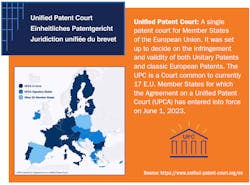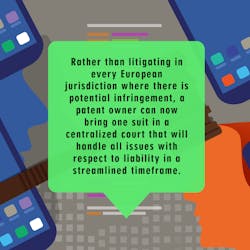The Unified Patent Court (UPC) is poised to upend the European patent landscape with its launch on June 1, 2023. Rather than litigating in every jurisdiction where there is potential infringement, a patent owner can now bring one suit in a centralized court that will handle all issues with respect to liability in a streamlined timeframe. This article focuses on the practicalities of the new court and what LED lighting companies doing business in Europe need to know going forward.
On the litigation (contentious) side, the UPC will allow companies to bring a single infringement action that covers infringing acts in any of the member states. In the UPC, patent owners can assert both Unitary Patents — a patent issued via the new streamlined and central prosecution process — and the traditional European patents, rather than filing separate actions across multiple countries in Europe. Depending on the type of action, parties will file their cases in Local Divisions throughout Europe or in the Central Division, which has three branches.
And unlike most local European jurisdictions, litigations brought in the UPC will have a timeframe of just over one year from filing to reach a determination of liability, including infringement and validity. Although that is fast, keep in mind that this first proceeding only addresses liability. Once liability is established, a second proceeding for damages is then initiated. A single court in Luxembourg hears all appeals, which are expected to take a year.
LED lighting companies used to the multiple and lengthy phases of litigation in U.S. courts — including claim construction, fact discovery, expert discovery, pretrial disclosures, and trial — will find the UPC proceedings procedurally more akin to an inter partes review proceeding before the U.S. Patent Trial and Appeals Board. In those proceedings, parties litigate the validity of patents via a series of briefs and expert declarations, with little to no traditional discovery, and a decision on the merits is due within a statutory timeframe of one year from institution of the proceeding.
How does a UPC infringement action start?
To initiate an infringement action, the patent owner files a Statement of claim. The Statement includes facts, evidence, and legal argument demonstrating infringement. This evidence can include written witness statements and expert declarations.
An alleged infringer then has three months to file a Statement of defense, which similarly contains facts, evidence, and legal argument demonstrating non-infringement. At that time, the alleged infringer can also file a counterclaim for revocation, declaring that the asserted patent is invalid.
The patent owner then files a reply in support of its original Statement relating to infringement, a Statement of defense with respect to the invalidity claim (if filed), and may also move to amend the patent claims. Each party completes its briefing, with each allowed two papers per issue. The patent owner gets an initial Statement and reply relating to infringement, while the accused infringer gets a Statement of defense and a sur-reply relating to non-infringement.
Discovery — Who needs it?
Conspicuously missing from the aforementioned process is the several-years-long fact discovery period typical of a district court litigation in the U.S. There are no automatic disclosures; any discovery that a party seeks from the other side must be specifically requested and its production subsequently ordered by the judge. Given the fast pace of these proceedings, parties will likely need to rely on evidence already within their control.
Fast track to a one-day trial
Following the written procedure phase, the proceeding then enters an interim procedure phase. An interim conference, akin to a pretrial conference in the U.S., may be held. During the interim procedure, both parties crystallize the issues in dispute, the judge rules upon orders regarding discovery and orders further scheduling for the rest of the proceeding, then all participants discuss the possibility of settlement. The interim procedure lasts three months, then the oral procedure follows.
During the oral procedure, an oral hearing is held and expected to be completed in a single day. The parties present their oral arguments and any witness testimony. Following the hearing, the court is expected to issue a decision on the merits within six weeks. If the patent owner prevails, it then has one year from the final decision on the merits — including all appeals — to bring a separate proceeding to determine damages. Unlike in the U.S., where each party bears its own costs for the litigation, the successful party during the UPC liability phase may bring a cost proceeding to recover its litigation costs from the losing party.
Invalidating a patent at the UPC
Rather than wait to be sued, an LED lighting company expecting an infringement suit can first file a stand-alone revocation action challenging the validity of a questionable patent. Unlike the infringement action, which is heard by one of the local divisions, revocation actions are heard by the Central Division headquartered in Paris, with sections in Munich and Milan — the latter replacing London following Brexit.
The division of proceedings is based on the patent classification or art unit of the challenged patent. The World Intellectual Property Organization (WIPO) classification organizes patents into different technology areas. LED lighting companies should note that the Munich section will hear revocation actions involving lighting-related patents, classified as F21, under the WIPO system.
A patent owner may bring counterclaims for infringement in a revocation proceeding. As the UPC cases proceed, LED lighting companies should consider whether it is more beneficial to wait for an infringement suit — brought where the infringement occurs or where the alleged infringer is located — or preemptively file a revocation action that will be heard by judges in Munich.
Fees, fees, fees
Both infringement and revocation actions require payment of an initial set fee; current fees are €11,000 for filing an infringement action and €20,000 for filing a revocation action. A value-based fee must also be paid for actions involving infringement, based on the value of the case and determined by the court during the interim procedure. It ranges from €0 for a case valued at less than €500,000 up to €325,000 for a case valued at more than €50,000,000.
Protective letters: A sneak-attack injunction
With respect to the UPC, perhaps the most important activities for LED lighting companies to understand right now are provisional measures and protective letters. A patent owner may apply for provisional measures with the UPC, requesting an injunction, the seizure of allegedly infringing goods, or a freeze of assets held in bank accounts. Critically, the UPC has the power to grant this relief ex parte — without the alleged infringer having the opportunity to be heard — in cases where delay might cause irreparable harm to the patent owner or where there is a chance that evidence may be destroyed.
To counterbalance the risk of provisional measures being imposed ex parte, an alleged infringer can file a protective letter, which can serve as a preemptive Statement of defense. The letter contains arguments from the alleged infringer regarding why it should not be subjected to provisional measures; it is the equivalent of opposing a motion for a preliminary injunction in the U.S. but filed before the triggering motion is filed, and it contains facts, evidence, and law. A €200 fee is required to file the letter — considerably lower than the fees for infringement and revocation actions.
Once filed, the protective letter is not served on the patent owner nor is it made publicly available. Rather, the letter is sent to the patent owner only in the event that a request for provisional measures is subsequently filed. At that time, it is also sent to the appointed judge or panel hearing the request for provisional measures. A protective letter is only kept on file for six months; if no request for provisional measures is filed within that timeframe, the letter is removed from the UPC registry unless the alleged infringer pays a €100 fee to extend its expiration, with further extensions available upon additional payment.
The purpose of the protective letter is to protect the alleged infringer from the judge or panel issuing protective measures without that party getting a chance to be heard. In the case where a party has filed a protective letter and a patent owner subsequently files a request for provisional measures, the judge or panel will have arguments from both sides before issuing any remedy.
Notably, as of June 26, 2023, the UPC had received 236 protective letters, compared to only 4 applications for provisional measures. Thus, parties are taking the imposition of protective measures seriously even though the number of requests for provisional remedies has been relatively low so far. Additionally, in that first month of the UPC, 3 Revocation actions and 14 infringement actions were filed.
As noted by the UPC Administrative Committee, these numbers are likely to change dynamically as the months go by, and LED lighting companies should be monitoring the volume of new filings. In this way, they can be prepared for what is expected to be a popular avenue for enforcement and/or defense of patent rights across the E.U. market, and assess whether it makes sense to turn to the UPC or whether to continue litigating their patents in the local jurisdictions.
JONATHAN AUERBACH is a patent litigator and DAVID C. RADULESCU is founder and partner at Radulescu LLP, a New York–based patent litigation firm that represents many technology innovators.
Follow our LinkedIn page for our latest news updates, contributed articles, and commentary, and our Facebook page for events announcements and more. You can also find us on the X platform.








